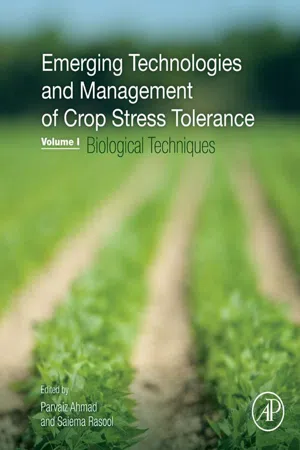
Emerging Technologies and Management of Crop Stress Tolerance
Volume 1-Biological Techniques
- 592 pages
- English
- ePUB (mobile friendly)
- Available on iOS & Android
Emerging Technologies and Management of Crop Stress Tolerance
Volume 1-Biological Techniques
About This Book
Emerging Technologies and Management of Crop Stress Tolerance: Volume 1 - Biological Techniques presents the latest technologies used by scientists for improvement the crop production and explores the various roles of these technologies for the enhancement of crop productivity and inhibition of pathogenic bacteria that can cause disease.
This resource provides a comprehensive review of how proteomics, genomics, transcriptomics, ionomics, and micromics are a pathway to improve plant stress tolerance to increase productivity and meet the agricultural needs of the growing human population. This valuable resource will help any scientist have a better understanding of environmental stresses to improve resource management within a world of limited resources.
- Includes the most recent advances methods and applications of biotechnology to crop science
- Discusses different techniques of genomics, proteomics, transcriptomics and nanotechnology
- Promotes the prevention of potential diseases to inhibit bacteria postharvest quality of fruits and vegetable crops by advancing application and research
- Presents a thorough account of research results and critical reviews
Frequently asked questions
Information
Genomic Approaches and Abiotic Stress Tolerance in Plants
Keywords
1.1 Introduction
1.2 Physiological, cellular, and biochemical mechanisms of abiotic stress in plants
Table of contents
- Cover image
- Title page
- Table of Contents
- Copyright
- Dedication
- Preface
- Acknowledgments
- About the Editors
- List of Contributors
- Chapter 1. Genomic Approaches and Abiotic Stress Tolerance in Plants
- Chapter 2. Metabolomics Role in Crop Improvement
- Chapter 3. Transcription Factors and Environmental Stresses in Plants
- Chapter 4. Plant Resistance under Cold Stress: Metabolomics, Proteomics, and Genomic Approaches
- Chapter 5. Genetic Engineering of Crop Plants for Abiotic Stress Tolerance
- Chapter 6. Bt Crops: A Sustainable Approach towards Biotic Stress Tolerance
- Chapter 7. Modern Tools for Enhancing Crop Adaptation to Climatic Changes
- Chapter 8. Interactions of Nanoparticles with Plants: An Emerging Prospective in the Agriculture Industry
- Chapter 9. Role of miRNAs in Abiotic and Biotic Stresses in Plants
- Chapter 10. Gene Silencing: A Novel Cellular Defense Mechanism Improving Plant Productivity under Environmental Stresses
- Chapter 11. The Role of Carbohydrates in Plant Resistance to Abiotic Stresses
- Chapter 12. Role of Glucosinolates in Plant Stress Tolerance
- Chapter 13. Plant Responses to Iron, Manganese, and Zinc Deficiency Stress
- Chapter 14. Role of Trace Elements in Alleviating Environmental Stress
- Chapter 15. Nutritional Stress in Dystrophic Savanna Soils of the Orinoco Basin: Biological Responses to Low Nitrogen and Phosphorus Availabilities
- Chapter 16. Silicon and Selenium: Two Vital Trace Elements that Confer Abiotic Stress Tolerance to Plants
- Chapter 17. Herbicides, Pesticides, and Plant Tolerance: An Overview
- Chapter 18. Effects of Humic Materials on Plant Metabolism and Agricultural Productivity
- Chapter 19. Climate Changes and Potential Impacts on Quality of Fruit and Vegetable Crops
- Chapter 20. Interplays of Plant Circadian Clock and Abiotic Stress Response Networks
- Chapter 21. Development of Water Saving Techniques for Sugarcane (Saccharum officinarum L.) in the Arid Environment of Punjab, Pakistan
- Index